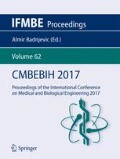Abstract
Diabetes is a group of metabolic diseases characterized by hyperglycemia resulting from defects in insulin secretion, insulin action, or both. It is proven that electrical stimulation could accelerate wound or fracture healing and also decreases pain. Because of numerous benefits on cell function, it is assumed that electrical stimulation can have positive effect on diabetes. Aim of this article is to summarize results of different studies which analyzed effect of electrical stimulation on most important parameters of diabetes mellitus in animal models. Unilateral electrical stimulation of dorsal motor nucleus of the vagus nerve resulted in rapid rise in plasma insulin levels >200%, and stimulation of the nucleus tractus solitarius, also produced 50% increase in insulinemia, in Wistar rats. Mild electrical stimulation (MES) combined with heath shock treatment (HS), significantly decreased fasting blood glucose and insulin levels, and improved insulin sensitivity in C57BL/6J, db/db mice as well as in KKAy mice. Peripheral electrical stimulation (PES) increased hepatic glucose output during the basal state in insulin-resistant Wistar-Han rats. PES improved tissue sensitivity to insulin, improved suppression of hepatic glucose production, and significantly elevated rate of glycogenesis compared with controls. Hepatic electrical stimulation was effective in reducing blood glucose by 27-31%, in Sprague-Dawley rats, streptozocin induced diabetic rats and Fa/Fa diabetic fatty rats. The present studies indicate that electrical stimulation treatment of very short duration is very potent to stimulate glucose uptake and improve insulin sensitivity. Electrical stimulation may directly affect major insulin target tissues or leading to secondary effects in other tissues. Low intensity current showed no observable adverse effects, but electrical conductance in cells should be measured. Electrical stimulation has very positive impact on diabetes in animal models, so it should be subject of further examinations for human use.
Access this chapter
Tax calculation will be finalised at checkout
Purchases are for personal use only
Preview
Unable to display preview. Download preview PDF.
References
Adeghate E, P. A. (2001). Effect of electrical field stimulation on insulin and glucagon secretion from the pancreas of normal and diabetic rats. Horm Metab Res, 33(5):281-9.
American Diabetes Assosiation. (2014). Diagnosis and Classification of Diabetes Mellitus. Diabetes Care, 27: 5-10.
Catalogna M, F. S.-S.-J. (2016). Regulation of glucose dynamics by noninvasive peripheral electrical stimulation in normal and insulin-resistant rats. Metabolism, 65(6):863-73.
Cefalu WT. (2006). Animal Models of Type 2 Diabetes: Clinical Presentation and Pathophysiological Relevance to the Human Condition. ILAR J, 47 (3): 186198.
Chen J, P. P. (2010). Hepatic electrical stimulation reduces blood glucose in diabetic rats. Neurogastroenterol Motil, 22(10):1109-e286.
Fu Z, G. E. (2013). Regulation of insulin synthesis and secretion and pancreatic Betacell dysfunction in diabetes. Curr Diabetes Rev, 1;9(1):25-53.
Groves DA, B. V. (2005). Vagal nerve stimulation: a review of its applications and potential mechanisms that mediate its clinical effects. Neurosci Biobehav Rev, 29(3):493-500.
Howell SL. (1984). The mechanism of insulin secretion. Diabetologia, 26(5):319–27.
Ionescu E, R.-J. F. (1983). Increases in plasma insulin levels in response to electrical stimulation of the dorsal motor nucleus of the vagus nerve. Endocrinology, 112(3):904-10.
Kai Y, T. Y. (2016). The effect of mild electrical stimulation with heat shock on diabetic KKAy mice. Integr Mol Med, 3.
King AJ. (2012). The use of animal models in diabetes research. Br J Pharmacol, 66(3):877-94.
Morino S, K. T. (2008). Mild electrical stimulation with heat shock ameliorates insulin resistance via enhanced insulin signaling. PLoS One, 3(12):e4068.
Pandey AK, B. V. (2009). Tumour necrosis factor-alpha attenuates insulin action on phosphoenolpyruvate carboxykinase gene expression and gluconeogenesis by altering the cellular localization of Foxa2 in HepG2 cells. FEBS J, 276(14):3757-69.
Poitout V, H. D. (2006). Regulation of the insulin gene by glucose and fatty acids. J Nutr, 136(4):873-6.
Quesada I, T. E. (2008). Physiology of the pancreatic alpha-cell and glucagon secretion: role in glucose homeostasis and diabetes. J Endocrinol, 199(1):5- 19.
Richter EA, H. M. (2013). Exercise, GLUT4, and skeletal muscle glucose uptake. Physiol Rev, 93(3):993-1017.
Roden M, B. E. (2003). Hepatic glucose metabolism in humans--its role in health and disease. BestPractRes Clin EndocrinolMetab, 17(3):365-83.
Suckale J, S. M. (2008). Pancreas islets in metabolic signaling--focus on the beta-cell. Front Biosci, 13:7156-71.
Author information
Authors and Affiliations
Corresponding author
Editor information
Editors and Affiliations
Rights and permissions
Copyright information
© 2017 Springer Nature Singapore Pte Ltd.
About this paper
Cite this paper
Divanović, H. et al. (2017). Effects of electrical stimulation as a new method of treating diabetes on animal models: Review. In: Badnjevic, A. (eds) CMBEBIH 2017. IFMBE Proceedings, vol 62. Springer, Singapore. https://doi.org/10.1007/978-981-10-4166-2_38
Download citation
DOI: https://doi.org/10.1007/978-981-10-4166-2_38
Published:
Publisher Name: Springer, Singapore
Print ISBN: 978-981-10-4165-5
Online ISBN: 978-981-10-4166-2
eBook Packages: EngineeringEngineering (R0)

